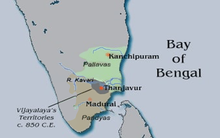Vijayalaya Chola (r. 847 – 871 CE; Tamil: விசயாலய சோழன், romanized: Vicayālaya Cōḻaṉ) founded the Imperial Chola Empire.[1] He ruled over the region to the north of the river Kaveri. He is one of the descendants of the famous Sangam age Chola king, Karikala Chola. Vijayalaya was succeeded by his son Aditya Chola I who laid the foundation of the Imperial Chola Empire.
| Vijayalaya Chola | |
|---|---|
| Parakesarivarman | |
 Vijayalaya's Territories c. 850 CE | |
| Reign | c. 847 – c. 871 CE |
| Military career | |
| Service | Chola Army Pallava Governor (847 CE – 860 CE) |
| Successor | Aditya I |
| Born | Ottriyur (Tiruvottriyur) |
| Died | Around 884 CE Srikalahasti at Tirupathi |
| Issue | Aditya I |
| House | Chola |
| Dynasty | Chola |
| Religion | Hinduism |
This article has multiple issues. Please help improve it or discuss these issues on the talk page. (Learn how and when to remove these messages)
|
Dark age of Cholas
editThe ancient Chola kingdom, once famous in Tamil literature and the writings of Greek merchants and geographers faded into darkness after c. 300 CE. Cholas during this period almost completely disappeared from their native land. They have held on to their old capital city of Uraiyur. This dark age is said to have been caused by the invasion of the Kalabhras. This "dark" age of Tamil history came to an end with the ascendancy of the Pandyas and the Pallavas after overthrowing Kalabhras in 590 CE. The Cholas disappeared from the Tamil land almost completely in this debacle, though a branch of them can be traced towards the end of the dark period in Rayalaseema—the Andhra Chodas, whose kingdom is mentioned by Yuan Chwang in the seventh-century CE.[2]
Cholas under Pandyas and Pallavas
editDue to the Kalabhra invasion and the growing power of Pallavas, the Cholas migrated from their native country to Telugu lands and ruled from there as chieftains of Pallavas at least since 540 CE. The Cholas who were ruling the Telugu lands are called as Telugu Chodas or Telugu Cholas. The Cholas had to wait for another three centuries until the accession of Vijayalaya Chola.
Rise of Vijayalaya Chola
editMaking use of the opportunity during a war between the Pandyas and Pallavas, Vijayalaya rose out of obscurity and captured Thanjavur. However, there is no substantiated proof to verify the claim regarding his obscure beginnings. For a very long time, historians could not trace the ancestry of Vijayalaya Chola, who is considered to be the founder of the Medieval Chola dynasty.
Around mid ninth century CE, there was a great struggle going on between the Pallavas and the Pandyas for the political supremacy of South India. In this disturbed state of affairs, Vijayalaya Chola seems to have found a good opportunity to defeat the Pandyas, and make himself the ruler of Thanjavur and the surrounding Chola country. He also defeated the Pallavas.
Vijayalaya Chola conquered Thanjavur from Elango Mutharaiyar who was the final ruler of Mutharaiyar dynasty. It is said that in the year 852 CE Vijayalaya Chola waged war with Pandya's and defeated the latter. Making use of the opportunity during a war between Pandyas and Pallavas, Vijayalaya rose and established the Chola kingdom at Thanjavur with help of Muttaraiyar king Sattan Paliyilli (826–852 CE). Cholas became so powerful that the Pallavas were also wiped out from the Thanjavur region at a later stage.
Pandyan invasion
editAfter Vijayalaya’s capture of Thanjavur, the Pandyan king Varagunavarman II (c. 862 – 885 CE) became a subordinate ally of the Pallava Nandivarman III (c. 846 – 869 CE). Nandhivarman wished to curtail the growing influence of Chola power under Vijayalaya and called upon the Varagunavarman to help suppress Vijayalaya. Varaguna led an expedition into the Chola country. The Pandyan army reached the north bank of the Kaveri near Thanjavur and for a while the Chola revival looked short lived. Vijayalaya, by this time a veteran of many battles, was aging and was an invalid. By this time Vijayalaya lost his kingdom to the Pandyas and he became a tax paying king under the Pandya reign but the Cholas who succeeded him conquered the Pandya kingdom.
Inscriptions of Vijayalaya
editThe Tiruvalangadu plates state that Vijayalaya captured the city of Tanjavur and made it his capital and that he also built in it a temple to the goddess Nisumbhasudani (Durga). The Kanyakumari inscription states that he renovated the city of Tanjore.
Vijayalaya took the title of Tamil: பரகேசரிவர்மன், romanized: Parakēcarivarmaṉ, lit. 'Great son who is a lion to his enemies'. The suffix Tamil: வர்மன், romanized: Varmaṉ is according to S. Ramachandran a corrupt version of the Tamil word Tamil: பெருமகன், romanized: Great son, lit. 'Perumakaṉ'.
It goes as following – Perumagan (பெருமகன்) -> Perumaan (பெருமான்) -> Peruman (பெருமன்) -> Paruman (பருமன்) -> Varuman (வருமன்) -> Varman (வர்மன்) -> Varmaa (வர்மா).
Chola kings succeeding him took the titles of Tamil: பரகேசரி, romanized: Parakēcari, lit. 'One who is a lion to his enemy'. This is probably to acknowledge their supposed ancestors Parakesari.
Narttamalai, Pudukkottai has a solesvara temple attributed to Vijayalaya.
References
edit- ^ Sen, Sailendra (2013). A Textbook of Medieval Indian History. Primus Books. pp. 46–49. ISBN 978-9-38060-734-4.
- ^ K.A., Nilakanta Sastri (1955). A History of South India from Prehistoric to the Fall of Vijayanagar. Oxford University Press. pp. Page=139–140.
Sources
edit- Tamil And Sanskrit Inscriptions Chiefly Collected In 1886 - 87, E. Hultzsch, Ph.D., Published by Archaeological Survey of India, New Delhi
- Nilakanta Sastri, K. A. (1935). The CōĻas, University of Madras, Madras (Reprinted 1984).
- Nilakanta Sastri, K. A. (1955). A History of South India, OUP, New Delhi (Reprinted 2002).